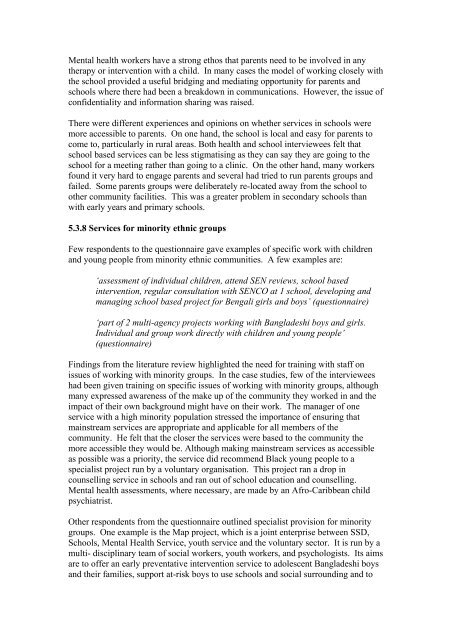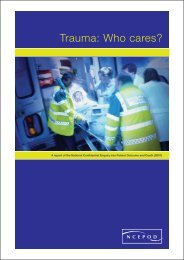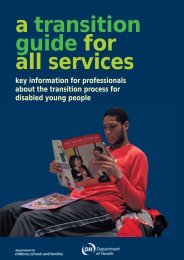(CAMHS) and Schools - London Health Programmes
(CAMHS) and Schools - London Health Programmes
(CAMHS) and Schools - London Health Programmes
Create successful ePaper yourself
Turn your PDF publications into a flip-book with our unique Google optimized e-Paper software.
Mental health workers have a strong ethos that parents need to be involved in any<br />
therapy or intervention with a child. In many cases the model of working closely with<br />
the school provided a useful bridging <strong>and</strong> mediating opportunity for parents <strong>and</strong><br />
schools where there had been a breakdown in communications. However, the issue of<br />
confidentiality <strong>and</strong> information sharing was raised.<br />
There were different experiences <strong>and</strong> opinions on whether services in schools were<br />
more accessible to parents. On one h<strong>and</strong>, the school is local <strong>and</strong> easy for parents to<br />
come to, particularly in rural areas. Both health <strong>and</strong> school interviewees felt that<br />
school based services can be less stigmatising as they can say they are going to the<br />
school for a meeting rather than going to a clinic. On the other h<strong>and</strong>, many workers<br />
found it very hard to engage parents <strong>and</strong> several had tried to run parents groups <strong>and</strong><br />
failed. Some parents groups were deliberately re-located away from the school to<br />
other community facilities. This was a greater problem in secondary schools than<br />
with early years <strong>and</strong> primary schools.<br />
5.3.8 Services for minority ethnic groups<br />
Few respondents to the questionnaire gave examples of specific work with children<br />
<strong>and</strong> young people from minority ethnic communities. A few examples are:<br />
‘assessment of individual children, attend SEN reviews, school based<br />
intervention, regular consultation with SENCO at 1 school, developing <strong>and</strong><br />
managing school based project for Bengali girls <strong>and</strong> boys’ (questionnaire)<br />
‘part of 2 multi-agency projects working with Bangladeshi boys <strong>and</strong> girls.<br />
Individual <strong>and</strong> group work directly with children <strong>and</strong> young people’<br />
(questionnaire)<br />
Findings from the literature review highlighted the need for training with staff on<br />
issues of working with minority groups. In the case studies, few of the interviewees<br />
had been given training on specific issues of working with minority groups, although<br />
many expressed awareness of the make up of the community they worked in <strong>and</strong> the<br />
impact of their own background might have on their work. The manager of one<br />
service with a high minority population stressed the importance of ensuring that<br />
mainstream services are appropriate <strong>and</strong> applicable for all members of the<br />
community. He felt that the closer the services were based to the community the<br />
more accessible they would be. Although making mainstream services as accessible<br />
as possible was a priority, the service did recommend Black young people to a<br />
specialist project run by a voluntary organisation. This project ran a drop in<br />
counselling service in schools <strong>and</strong> ran out of school education <strong>and</strong> counselling.<br />
Mental health assessments, where necessary, are made by an Afro-Caribbean child<br />
psychiatrist.<br />
Other respondents from the questionnaire outlined specialist provision for minority<br />
groups. One example is the Map project, which is a joint enterprise between SSD,<br />
<strong>Schools</strong>, Mental <strong>Health</strong> Service, youth service <strong>and</strong> the voluntary sector. It is run by a<br />
multi- disciplinary team of social workers, youth workers, <strong>and</strong> psychologists. Its aims<br />
are to offer an early preventative intervention service to adolescent Bangladeshi boys<br />
<strong>and</strong> their families, support at-risk boys to use schools <strong>and</strong> social surrounding <strong>and</strong> to

















